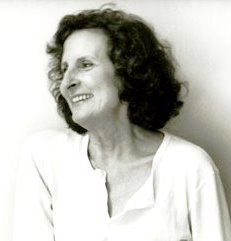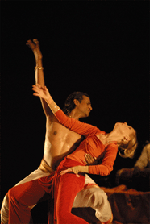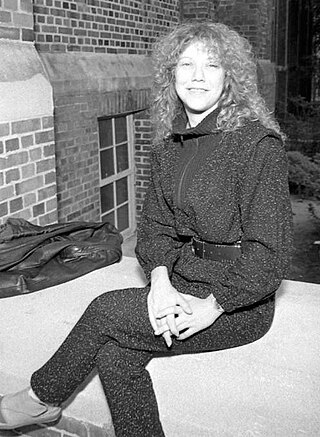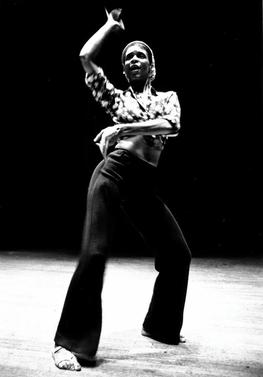Related Research Articles
Dance improvisation is the process of spontaneously creating movement. Development of movement material is facilitated through a variety of creative explorations including body mapping through levels, shape and dynamics schema.
Judson Dance Theater was a collective of dancers, composers, and visual artists who performed at the Judson Memorial Church in Greenwich Village, Manhattan New York City between 1962 and 1964. The artists involved were avant garde experimentalists who rejected the confines of Modern dance practice and theory, inventing as they did the precepts of Postmodern dance.
Postmodern dance is a 20th century concert dance form that came into popularity in the early 1960s. While the term "postmodern" took on a different meaning when used to describe dance, the dance form did take inspiration from the ideologies of the wider postmodern movement, which "sought to deflate what it saw as overly pretentious and ultimately self-serving modernist views of art and the artist" and was, more generally, a departure from modernist ideals. Lacking stylistic homogeny, Postmodern dance was discerned mainly by its anti-modern dance sentiments rather than by its dance style. The dance form was a reaction to the compositional and presentational constraints of the preceding generation of modern dance, hailing the use of everyday movement as valid performance art and advocating for unconventional methods of dance composition.

Yvonne Rainer is an American dancer, choreographer, and filmmaker, whose work in these disciplines is regarded as challenging and experimental. Her work is sometimes classified as minimalist art. Rainer currently lives and works in New York.

Trisha Brown was an American choreographer and dancer, and one of the founders of the Judson Dance Theater and the postmodern dance movement. Brown’s dance/movement method, with which she and her dancers train their bodies, remains pervasively impactful within international postmodern dance.

Kenneth Charles Knowlton was an American computer graphics pioneer, artist, mosaicist and portraitist. In 1963, while working at Bell Labs, he developed the BEFLIX programming language for creating bitmap computer-produced movies. In 1966, also at Bell Labs, he and Leon Harmon created the computer artwork Computer Nude .
Lillian Elaine Summers was an American choreographer, experimental filmmaker, and intermedia pioneer. She was a founding member of the original workshop-group that would form the Judson Dance Theater and she significantly contributed to the interaction of film and dance, as well as the expansion of dance into other related disciplines, such as visual art, film, and theater. She fostered the expansion of performing dance in new, often outdoor locations. Her movement approach Kinetic Awareness offers a comprehensive perspective on human movement and dance.

David Gordon was an American dancer, choreographer, writer, and theatrical director prominent in the world of postmodern dance and performance. Based in New York City, Gordon's work has been seen in major performance venues across the United States, Europe, South America and Japan, and has appeared on television on PBS's Great Performances and Alive TV, and the BBC and Channel 4 in Great Britain.
Lucinda Childs is an American postmodern dancer and choreographer. Her compositions are known for their minimalistic movements yet complex transitions. Childs is most famous for being able to turn the slightest movements into intricate choreography. Through her use of patterns, repetition, dialect, and technology, she has created a unique style of choreography that embraces experimentation and transdisciplinarity.
Margaret Jenkins is a postmodern choreographer based in San Francisco, California. She was a Guggenheim Fellow in 1980 and in 2003, San Francisco mayor, Willie Brown, declared April 24 to be Margaret Jenkins Day.

Carolyn Carlson is an American born French nationalized contemporary dance choreographer, performer, and poet. She is of Finnish descent.
Robert Ellis Dunn was an American musician and choreographer who led classes in dance composition, contributing to the birth of the postmodern dance period in the early 1960s in New York City.

Sally Rachel Banes was a notable dance historian, writer, and critic.
Valda Setterfield was a British-born American postmodern dancer and actress. She was noted for her work as a soloist with the Merce Cunningham Dance Company and for her performances in works by her husband, postmodern choreographer and director David Gordon. She was described as his muse, and together they were called "The Barrymores of post-modern dance." Their son, playwright, theatrical director and actor Ain Gordon, has worked with Setterfield on a number of projects as well.

James Waring was a dancer, choreographer, costume designer, theatre director, playwright, poet, and visual artist, based in New York City from 1949 until his death in 1975. He was a prolific choreographer and teacher. He has been called "one of the most influential figures in the New York avant-garde in the late fifties and early sixties", "one of dance's great eccentrics", "a focal point for dance experimentation before the existence of the Judson Dance Theater", and "the quintessential Greenwich Village choreographer in the late 1950s and 1960s". Waring's collage style of building dance works influenced the development of the avant-garde Happenings which were staged in the late 1950s.
Barbara Dilley (Lloyd) (born 1938) is an American dancer, performance artist, improvisor, choreographer and educator, best known for her work as a prominent member of the Merce Cunningham Dance Company (1963-1968), and then with the groundbreaking dance and performance ensemble The Grand Union, from 1969 to 1976. She has taught movement and dance at Naropa University in Boulder, Colorado, since 1974, developing a pedagogy that emphasizes what she calls “embodied awareness,” an approach that combines dance and movement studies with meditation, “mind training” and improvisational composition. She served as the president of Naropa University from 1985 to 1993.
Sally Gross was an American postmodernist dancer.
Melanie Greene is an American writer, dancer, and choreographer. She is best known for being part of a dance ensemble, the skeleton architecture, which won a Bessies Award in 2017.

Joan Miller was an American dancer, choreographer, and educator. She was the artistic director of The Joan Miller Chamber Arts/Dance Players, a mixed-media dance company that used satire to make social commentary and provoke social change, from 1970 to 2007. Miller was also the founder and director of the dance program at Lehman College from 1970 to 2000.
Nina Martin is an American choreographer, dancer, and pedagogue. Originally from Austin, Texas, Martin moved to New York City, where she lived for 17 years. She currently resides in Fort Worth, Texas.
References
- ↑ "Deborah Hay", 10.31.12, Art Forum
- ↑ Hay Bio
- ↑ "Judson Dance Theater". 100 Dance Treasures. Dance Heritage Coalition. Archived from the original on 11 November 2018. Retrieved 27 September 2015.
- ↑ "Bell Labs & The Origins of the Multimedia Artist", November 8, 1998
- ↑ Ken Knowlton. "Mosaic Portraits: New Methods and Strategies" (PDF). PAGE 59 (Winter 2004/2005). Computer Arts Society. Archived from the original (PDF) on 2007-09-26.
- ↑ "Studies in Perception I (1966), by Knowlton & Leon Harmon". Archived from the original on 2009-06-29. Retrieved 2016-04-19.
- ↑ "A Critical History of Computer Graphics and Animation: Bell Labs". Archived from the original on 2006-09-06. Retrieved 2016-04-19.
- ↑ Gus Solomons, Jr., "The Deborah Hay Dance Company" in Dance Magazine (May, 2004)
- ↑ "Deborah Hay". Daniel Langlois Foundation. Archived from the original on 2010-07-03.
- ↑ Deborah Hay's No Time to Fly
- ↑ "Choreographer Deborah Hay's archive goes to the Harry Ransom Center". sites.utexas.edu. Retrieved 2021-10-13.